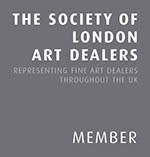
Arthur Dove American, 1880-1946
Untitled (Abstraction IV Geometric), 1941
Watercolor on paper
10.2 by 13.2 cm
4 x 5.5 in
4 x 5.5 in
1200005
Executed on 21 August 1941.
Provenance
Estate of the artist;
Terry Dintenfass, Inc., New York;
Acquired from the above in April 2003 by a private collector;
Acquired from the above by the present owner;
Exhibitions
JC Gallery, London, Arthur Dove: extraction, not abstraction, 2024JC Gallery, London, European vs American Modernism, 2024
Dove uses ink to render angular and rounded shapes, he then fills in these shapes with gouache using loose brush marks which create a sensitive textural landscape. The transparency of the paint over the ink creates a stained glass like effect which evokes a spiritual feeling in the viewer. Dove uses a palette of warm autumnal colours, burnt sienna, yellow ochre and primrose which are contrast with burnt umbers, viridian greens and blacks.
In the centre of the image a handwritten note is concealed beneath a field of yellow ochre colour which would form a half moon, if its corners were not obstructed. This tension, in which full shapes are obstructed by lines, scenes are flattened and brushwork is applied loosely and in differing directions reveals Dove’s appreciation of the textured brushwork and flat appearance of Fauvism and Cubism. In particular, Dove was influenced by Matisse’s fauvist works which he viewed on a trip to Paris with his wife from 1908-09.
Remarkably, 1941 was also the year French philosopher Henri Bergson, passed away. Bergson who emphasized the importance of a mystical rather than an analytical understanding of the world, was a great influence on Dove. His death is bound to have exorcised Dove’s passion for expressing the space between reality and imagination.
This intimate untitled work was created in 1941, towards the end of Doves’ life. Despite serious health issues during this decade, he remained dedicated to his art until his death in 1946. His legacy lives on and he has been credited with indirectly influencing many Abstract artists, such as Jackson Pollock and Mark Rothko.
In the centre of the image a handwritten note is concealed beneath a field of yellow ochre colour which would form a half moon, if its corners were not obstructed. This tension, in which full shapes are obstructed by lines, scenes are flattened and brushwork is applied loosely and in differing directions reveals Dove’s appreciation of the textured brushwork and flat appearance of Fauvism and Cubism. In particular, Dove was influenced by Matisse’s fauvist works which he viewed on a trip to Paris with his wife from 1908-09.
Remarkably, 1941 was also the year French philosopher Henri Bergson, passed away. Bergson who emphasized the importance of a mystical rather than an analytical understanding of the world, was a great influence on Dove. His death is bound to have exorcised Dove’s passion for expressing the space between reality and imagination.
This intimate untitled work was created in 1941, towards the end of Doves’ life. Despite serious health issues during this decade, he remained dedicated to his art until his death in 1946. His legacy lives on and he has been credited with indirectly influencing many Abstract artists, such as Jackson Pollock and Mark Rothko.
6
of
6
